2011 Hyundai H-1 (Grand Starex) seats
[x] Cancel search: seatsPage 20 of 346

3
Seats / 3-2
Seat belts / 3-13
Child restraint system / 3-24
Air bag - supplemental restraint system / 3-35
Safety features of your vehicle
Page 21 of 346

Safety features of your vehicle
2
3
C010000BTQ Front seat
(1) Forward and backward
(2) Seatback angle
(3) Seat cushion height (Driver’s seat)*
(4) Seat warmer (Driver’s seat)*(5) Headrest
2nd row seat* / 3rd row seat*
(6) Forward and backward/
Seat rotation (2nd row seat only)*
(7) Seatback angle (8) Headrest
4th row seat*
(9) Forward and backward
(10) Seat cushion folding(11) Headrest
*: if equipped
SEATS
OTQ037001E
The actual seats in the vehicle may differ from the illustration.
Page 22 of 346
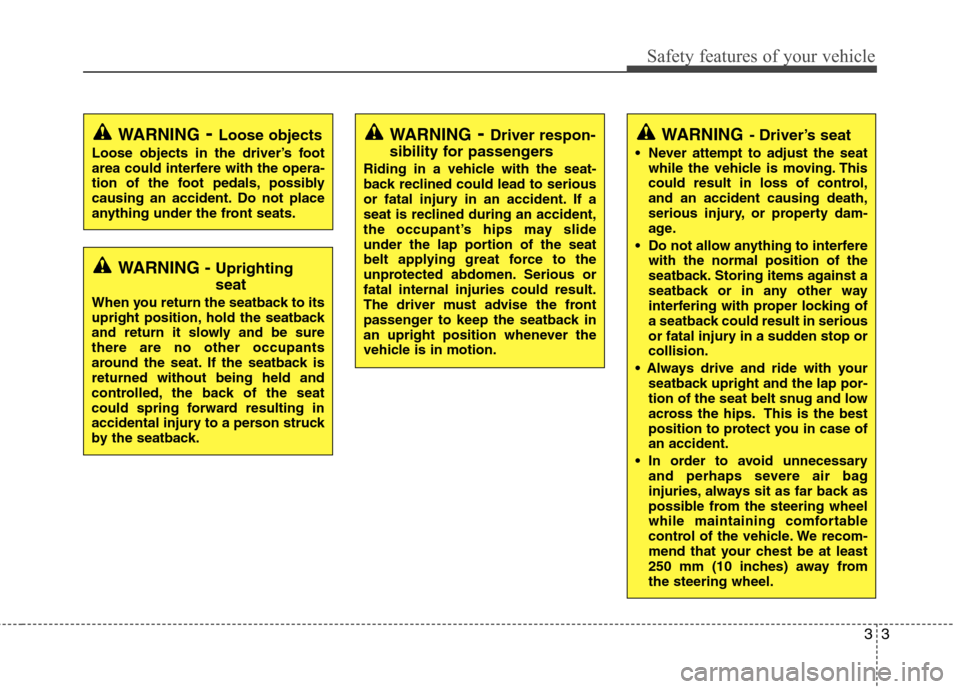
33
Safety features of your vehicle
WARNING- Driver’s seat
Never attempt to adjust the seat while the vehicle is moving. This
could result in loss of control,and an accident causing death,
serious injury, or property dam-
age.
Do not allow anything to interfere with the normal position of the
seatback. Storing items against a
seatback or in any other way
interfering with proper locking of
a seatback could result in serious
or fatal injury in a sudden stop orcollision.
seatback upright and the lap por-
tion of the seat belt snug and low
across the hips. This is the best
position to protect you in case ofan accident.
In order to avoid unnecessary and perhaps severe air bag
injuries, always sit as far back as
possible from the steering wheel
while maintaining comfortable
control of the vehicle. We recom-
mend that your chest be at least
250 mm (10 inches) away fromthe steering wheel.
WARNING - Uprighting seat
When you return the seatback to its
upright position, hold the seatback
and return it slowly and be surethere are no other occupants
around the seat. If the seatback isreturned without being held and
controlled, the back of the seat
could spring forward resulting in
accidental injury to a person struck
by the seatback.
WARNING - Loose objects
Loose objects in the driver’s foot
area could interfere with the opera-
tion of the foot pedals, possibly
causing an accident. Do not place
anything under the front seats.WARNING - Driver respon-
sibility for passengers
Riding in a vehicle with the seat-
back reclined could lead to serious
or fatal injury in an accident. If a
seat is reclined during an accident,
the occupant’s hips may slide
under the lap portion of the seat
belt applying great force to the
unprotected abdomen. Serious orfatal internal injuries could result.
The driver must advise the front
passenger to keep the seatback in
an upright position whenever the
vehicle is in motion.
Page 23 of 346

Safety features of your vehicle
4
3
Front seat adjustment
C010101AUN
Forward and backward
To move the seat forward or backward:
1. Pull the seat slide adjustment lever
under the front edge of the seat cush- ion up and hold it.
2. Slide the seat to the position you desire.
3. Release the lever and make sure the seat is locked in place.
Adjust the seat before driving, and make
sure the seat is locked securely by trying
to move forward and backward without
using the lever. If the seat moves, it is not
locked properly.
OTQ037002
(Continued)
When resetting the seatback to the upright position, make sure it
is securely latched by pushing it
forward and backwards.
To avoid the possibility of burns, do not remove the carpet in the
cargo area. Emission control
devices beneath this floor gener-ate high temperatures.WARNING- Rear seatbacks
The rear seatback must besecurely latched. If not, passen-
gers and objects could be thrown
forward resulting in serious
injury or death in the event of a
sudden stop or collision.
Luggage and other cargo should be laid flat in the cargo area. If
objects are large, heavy, or must
be piled, they must be secured.
Under no circumstances should
cargo be piled higher than the
seatbacks. Failure to follow thesewarnings could result in serious
injury or death in the event of a
sudden stop, collision or rollover.
No passenger should ride in the cargo area or sit or lie on folded
seatbacks while the vehicle is
moving. All passengers must be
properly seated in seats and
restrained properly while riding.
(Continued)
WARNING
After adjusting the seat, always
check that it is securely locked into
place by attempting to move the
seat forward or backward without
using the lock release lever.
Sudden or unexpected movement
of the driver's seat could cause you
to lose control of the vehicle result-ing in an accident.
Page 25 of 346
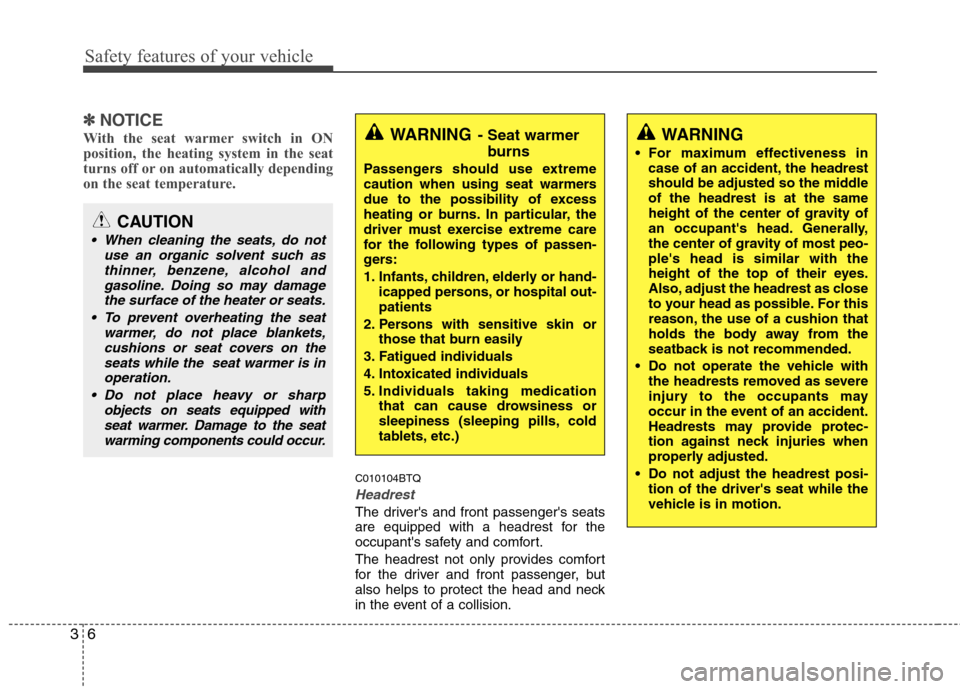
Safety features of your vehicle
6
3
✽✽
NOTICE
With the seat warmer switch in ON
position, the heating system in the seat
turns off or on automatically depending
on the seat temperature.
C010104BTQ
Headrest
The driver's and front passenger's seats
are equipped with a headrest for the
occupant's safety and comfort.
The headrest not only provides comfort
for the driver and front passenger, but
also helps to protect the head and neck
in the event of a collision.
WARNING
For maximum effectiveness in case of an accident, the headrest
should be adjusted so the middleof the headrest is at the same
height of the center of gravity of
an occupant's head. Generally,
the center of gravity of most peo-ple's head is similar with the
height of the top of their eyes.
Also, adjust the headrest as close
to your head as possible. For this
reason, the use of a cushion that
holds the body away from the
seatback is not recommended.
Do not operate the vehicle with the headrests removed as severe
injury to the occupants may
occur in the event of an accident.
Headrests may provide protec-
tion against neck injuries when
properly adjusted.
Do not adjust the headrest posi- tion of the driver's seat while the
vehicle is in motion.
CAUTION
When cleaning the seats, do not
use an organic solvent such asthinner, benzene, alcohol and
gasoline. Doing so may damage the surface of the heater or seats.
To prevent overheating the seat warmer, do not place blankets,cushions or seat covers on the
seats while the seat warmer is in operation.
Do not place heavy or sharp objects on seats equipped withseat warmer. Damage to the seat
warming components could occur.
WARNING - Seat warmer
burns
Passengers should use extreme
caution when using seat warmers
due to the possibility of excess
heating or burns. In particular, the
driver must exercise extreme care
for the following types of passen-
gers:
1. Infants, children, elderly or hand- icapped persons, or hospital out- patients
2. Persons with sensitive skin or those that burn easily
3. Fatigued individuals
4. Intoxicated individuals
5. Individuals taking medication that can cause drowsiness or
sleepiness (sleeping pills, cold
tablets, etc.)
Page 28 of 346
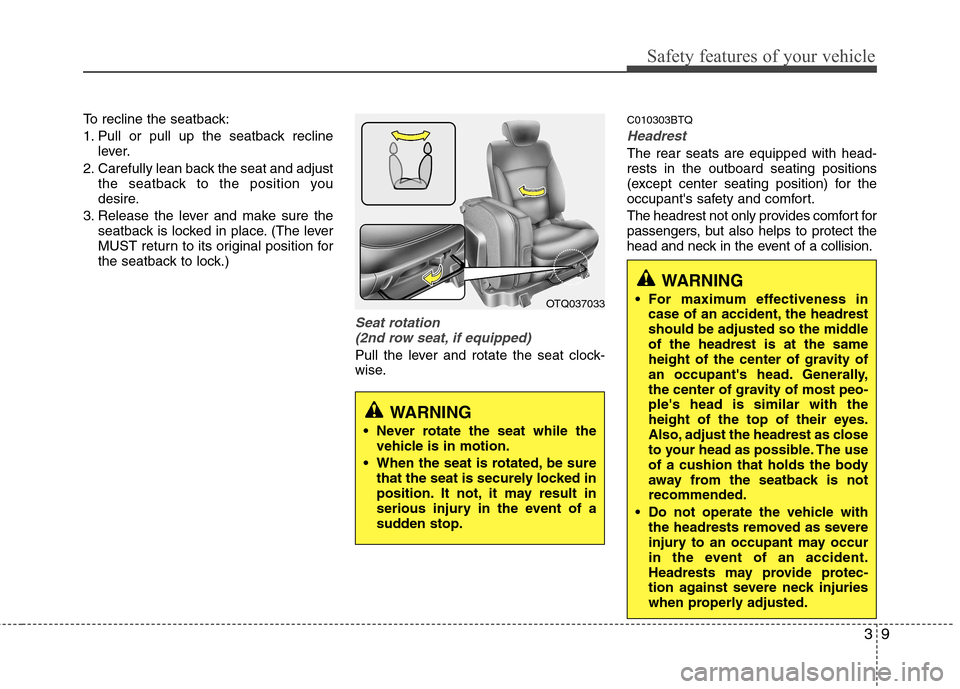
39
Safety features of your vehicle
To recline the seatback:
1. Pull or pull up the seatback reclinelever.
2. Carefully lean back the seat and adjust the seatback to the position you
desire.
3. Release the lever and make sure the seatback is locked in place. (The lever
MUST return to its original position for
the seatback to lock.)
Seat rotation
(2nd row seat, if equipped)
Pull the lever and rotate the seat clock-
wise. C010303BTQ
Headrest
The rear seats are equipped with head- rests in the outboard seating positions
(except center seating position) for the
occupant's safety and comfort.
The headrest not only provides comfort for
passengers, but also helps to protect the
head and neck in the event of a collision.
WARNING
For maximum effectiveness in case of an accident, the headrest
should be adjusted so the middleof the headrest is at the same
height of the center of gravity of
an occupant's head. Generally,
the center of gravity of most peo-ple's head is similar with the
height of the top of their eyes.
Also, adjust the headrest as close
to your head as possible. The use
of a cushion that holds the body
away from the seatback is notrecommended.
Do not operate the vehicle with the headrests removed as severe
injury to an occupant may occur
in the event of an accident.
Headrests may provide protec-
tion against severe neck injuries
when properly adjusted.
OTQ037033
WARNING
Never rotate the seat while the vehicle is in motion.
When the seat is rotated, be sure that the seat is securely locked in
position. It not, it may result in
serious injury in the event of a
sudden stop.
Page 30 of 346
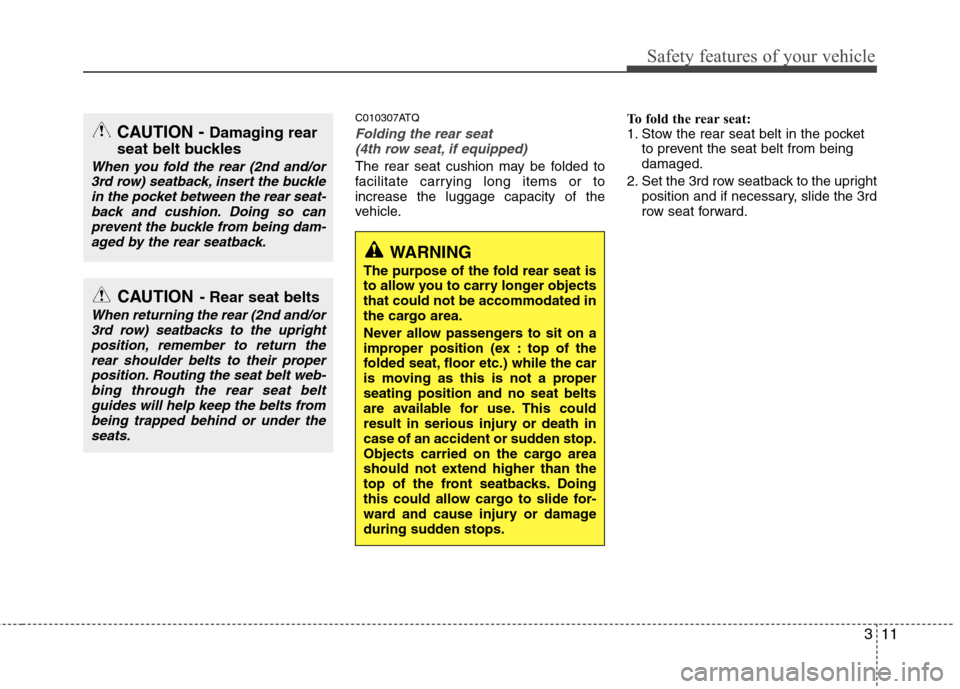
311
Safety features of your vehicle
C010307ATQ
Folding the rear seat (4th row seat, if equipped)
The rear seat cushion may be folded to
facilitate carrying long items or toincrease the luggage capacity of the
vehicle. To fold the rear seat:
1. Stow the rear seat belt in the pocket
to prevent the seat belt from beingdamaged.
2. Set the 3rd row seatback to the upright position and if necessary, slide the 3rd
row seat forward.
WARNING
The purpose of the fold rear seat is
to allow you to carry longer objectsthat could not be accommodated in
the cargo area.
Never allow passengers to sit on a
improper position (ex : top of the
folded seat, floor etc.) while the car
is moving as this is not a properseating position and no seat belts
are available for use. This could
result in serious injury or death in
case of an accident or sudden stop.
Objects carried on the cargo area
should not extend higher than the
top of the front seatbacks. Doing
this could allow cargo to slide for-
ward and cause injury or damage
during sudden stops.
CAUTION - Rear seat belts
When returning the rear (2nd and/or
3rd row) seatbacks to the upright
position, remember to return therear shoulder belts to their properposition. Routing the seat belt web- bing through the rear seat belt
guides will help keep the belts frombeing trapped behind or under theseats.
CAUTION - Damaging rear
seat belt buckles
When you fold the rear (2nd and/or 3rd row) seatback, insert the buckle
in the pocket between the rear seat-back and cushion. Doing so canprevent the buckle from being dam- aged by the rear seatback.
Page 32 of 346
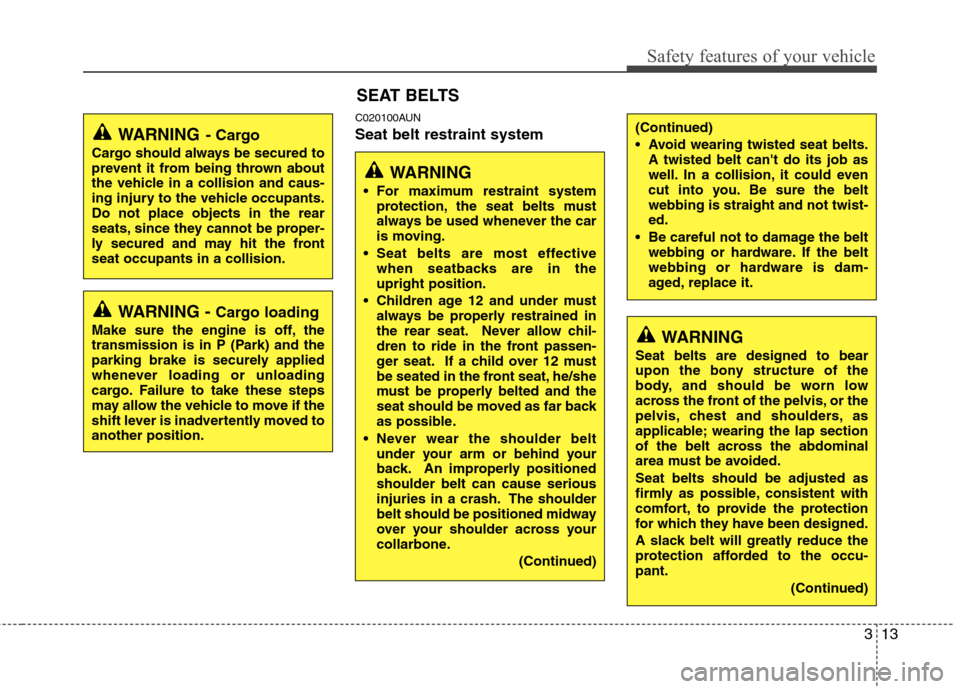
313
Safety features of your vehicle
C020100AUN Seat belt restraint system
WARNING
For maximum restraint system protection, the seat belts must
always be used whenever the car
is moving.
Seat belts are most effective when seatbacks are in theupright position.
Children age 12 and under must always be properly restrained in
the rear seat. Never allow chil-
dren to ride in the front passen-
ger seat. If a child over 12 must
be seated in the front seat, he/she
must be properly belted and the
seat should be moved as far back
as possible.
Never wear the shoulder belt under your arm or behind your
back. An improperly positionedshoulder belt can cause serious
injuries in a crash. The shoulder
belt should be positioned midway
over your shoulder across your
collarbone.
(Continued)
WARNING
Seat belts are designed to bear
upon the bony structure of the
body, and should be worn low
across the front of the pelvis, or the
pelvis, chest and shoulders, as
applicable; wearing the lap section
of the belt across the abdominal
area must be avoided. Seat belts should be adjusted as
firmly as possible, consistent with
comfort, to provide the protection
for which they have been designed.
A slack belt will greatly reduce the
protection afforded to the occu-pant. (Continued)
(Continued)
Avoid wearing twisted seat belts.A twisted belt can't do its job as
well. In a collision, it could even
cut into you. Be sure the beltwebbing is straight and not twist-ed.
Be careful not to damage the belt webbing or hardware. If the belt
webbing or hardware is dam-
aged, replace it.WARNING - Cargo
Cargo should always be secured to
prevent it from being thrown about
the vehicle in a collision and caus-
ing injury to the vehicle occupants.Do not place objects in the rear
seats, since they cannot be proper-
ly secured and may hit the frontseat occupants in a collision.
WARNING - Cargo loading
Make sure the engine is off, the
transmission is in P (Park) and the
parking brake is securely applied
whenever loading or unloading
cargo. Failure to take these steps
may allow the vehicle to move if the
shift lever is inadvertently moved toanother position.
SEAT BELTS